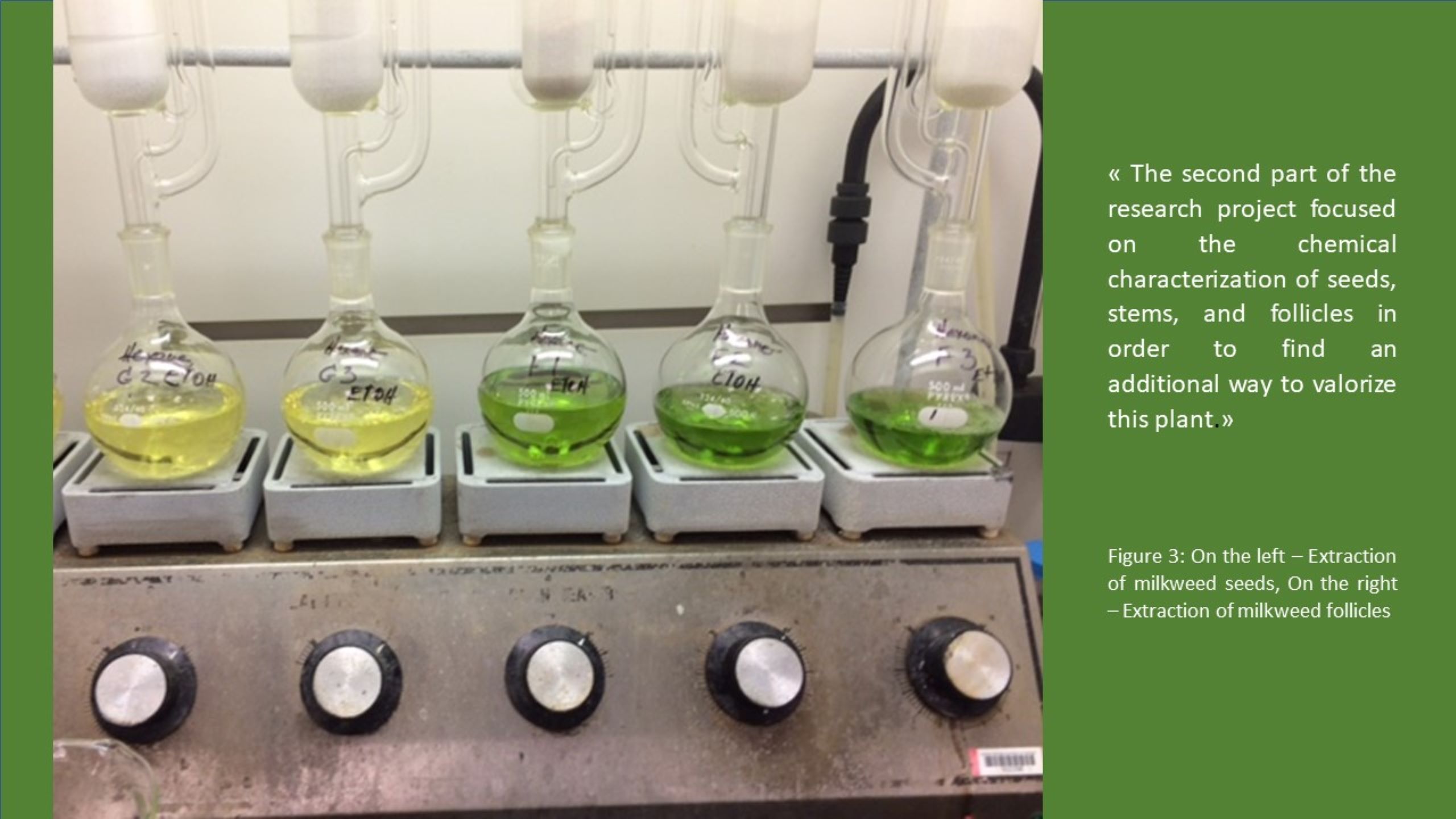Author: Annabelle St-Pierre, Researcher at Innofibre
Milkweed has gained in popularity in Quebec (Canada) ever since people have begun to recognize of the value of its silk. This plant generates a lot of interest for the textile industry for the manufacturing of warm clothing, seeing as its tubular fibers are light, hydrophobic, hypoallergenic and have a high thermal insulation capacity. In order to offer its support to the development of the milkweed production sector, the Innofibre team conducted a research project to learn more about the potential ways of adding value to this biomass.
Milkweed, a Fascinating Plant
Were you aware that the beautiful monarch butterflies that flutter around you during your strides are a clear indication that there are milkweed plants in the surrounding area? As a matter of fact, there exist four species of milkweed plants native to the province of Quebec, and these consist of the only food source that can be consumed by the monarch larvae. Even though this perennial plant has long been considered as undesirable for most people, we now know that it plays a crucial role in the environment.
Long before the cultivation of milkweed began, the First Nations peoples harvested this medicinal plant for its health benefits and for its nutritional value.
In recent years, there has been a rising trend in new industries wishing to exploit the milkweed plant. Farmers are investing in milkweed cultures and start-ups have been created to innovate milkweed-based products. However, there are many factors in the industrial chain that are unstable and an important one is the lack of intermediary businesses needed to be able to properly process these plants. Innofibre has been mandated to examine some of the technical challenges in this industrial chain, and to highlight the values of the various properties this plant has to offer.
Figure 1: Common Milkweed Plant
Silk Sheets made from Milkweed for Manufacturing Coats
The work that was carried out in Innofibre’s laboratory focused initially on the developing milkweed-based paper to be used as a thin, flexible insulator in coats. The idea behind densifying the milkweed silk into sheets is that this form makes it easier to handle this highly volatile material. Trials were conducted on different ways to prepare the pulp and different mixtures. Sheets were produces using milkweed silk on itself or in mixtures containing different proportions of hemp, milkweed follicles and starch.
The results of these trails showed that the presence of starch was beneficial in providing cohesion between the fibers and in providing good thermal insulation. However, the presence of starch also has the unwanted effect of reducing the flexibility. Therefore, the remaining challenge was to find a compromise between adhesion, flexibility, and thermal insulation.
Further trials were performed that have led to interesting findings: pressing the milkweed sheet at a certain temperature creates a flexible sheet with good adhesion between the fibers. The presence of milkweed follicles was also favorable for fiber adhesion. This finding suggests that the latex contained in the milkweed follicles could serve as a natural binder for the plant fibers.
Figure 2: Milkweed silk sheet obtained with the Heating Press
The Potential of Seeds and Follicles for Developing Nutraceutical Ingredients
The second part of the research project focused on determining the chemical composition of milkweed seeds, stems and follicles to find other ways of adding value to this plant. First, a pre-treatment was performed using ultrasounds, followed by an extraction with organic solvents. This allowed to obtain several interesting compounds. Indeed, an analysis of the chemical composition was performed by using a gas chromatography, coupled with a mass spectrometry, and showed that the milkweed seeds and follicles contain several fatty acids such as oleic acid, palmitoleic acid and linoleic acid, which are respectively, omega-3, omega-6 and omega-9.. These are lipids that have been highly acclaimed for their health benefits in the human diet. Conversely, the stems showed a dominance of palmitic acid, a saturated fatty acid which is undesirable in the diet.
This analysis also allowed us to identify the presence of triterpenes α-amyrin and β-amyrin in the milkweed seeds. These terpenes, which are found in a wide variety of plants, are known for their anti-inflammatory benefits.
Figure 3: Left – Milkweed seed Extraction, Right – Milkweed Follicle Extraction
To summarize, the work that was carried out has shown that there is great potential value in the milkweed plant. Firstly, the work performed by Innofibre has provided solutions for transforming the silk into sheets, which will make it easier to manufacture insulated clothing. In addition, this research has also demonstrated that there could be a potential use for milkweed seeds and follicles in food industries. These preliminary results should inspire milkweed producers to take advantage of the full potential contained in all the parts of this plant. Finally, companies that have expertise in textile conditioning could see the benefit in being implicated in this new and emerging industry and participate in the strengthening of its full processing.



